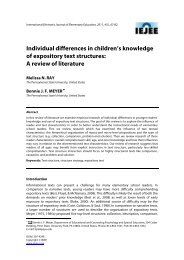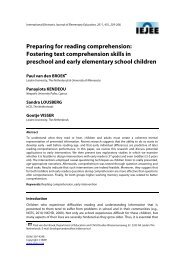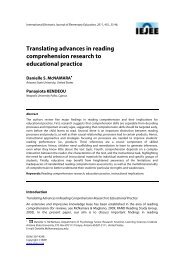The effects of syntactic and lexical complexity on the comprehension ...
The effects of syntactic and lexical complexity on the comprehension ...
The effects of syntactic and lexical complexity on the comprehension ...
You also want an ePaper? Increase the reach of your titles
YUMPU automatically turns print PDFs into web optimized ePapers that Google loves.
<str<strong>on</strong>g>The</str<strong>on</strong>g> Effects <str<strong>on</strong>g>of</str<strong>on</strong>g> Syntactic <str<strong>on</strong>g>and</str<strong>on</strong>g> Lexical / Arya, Hiebert & Pears<strong>on</strong>were n<strong>on</strong>-significant. We <strong>the</strong>n dropped <strong>the</strong> interacti<strong>on</strong> term from <strong>the</strong> model, leaving model4, in which <str<strong>on</strong>g>lexical</str<strong>on</strong>g> <str<strong>on</strong>g>complexity</str<strong>on</strong>g> affected performance but <str<strong>on</strong>g>syntactic</str<strong>on</strong>g> <str<strong>on</strong>g>complexity</str<strong>on</strong>g> did not.Model 4 explains a significant amount <str<strong>on</strong>g>of</str<strong>on</strong>g> variance for <strong>on</strong>ly two <str<strong>on</strong>g>of</str<strong>on</strong>g> <strong>the</strong> four topics, TreeFrogs <str<strong>on</strong>g>and</str<strong>on</strong>g> Soil. Similar results were not obtained for Jelly Beans <str<strong>on</strong>g>and</str<strong>on</strong>g> Toothpaste; for <strong>the</strong> lattertwo topics, nei<strong>the</strong>r <str<strong>on</strong>g>lexical</str<strong>on</strong>g> nor <str<strong>on</strong>g>syntactic</str<strong>on</strong>g> <str<strong>on</strong>g>complexity</str<strong>on</strong>g> affected performance.This final model suggests that high <str<strong>on</strong>g>lexical</str<strong>on</strong>g> <str<strong>on</strong>g>complexity</str<strong>on</strong>g> (i.e., more low frequency words) in<strong>the</strong> text is associated with lower performance <strong>on</strong> <strong>the</strong> test (p < .05). As would be predicted by<strong>the</strong> design <str<strong>on</strong>g>of</str<strong>on</strong>g> <strong>the</strong> passages, <strong>the</strong> impact <str<strong>on</strong>g>of</str<strong>on</strong>g> <str<strong>on</strong>g>lexical</str<strong>on</strong>g> <str<strong>on</strong>g>complexity</str<strong>on</strong>g> was limited to items in <strong>the</strong>middle 50% <str<strong>on</strong>g>of</str<strong>on</strong>g> <strong>the</strong> passage (<strong>the</strong> manipulated porti<strong>on</strong>s); <str<strong>on</strong>g>lexical</str<strong>on</strong>g> <str<strong>on</strong>g>complexity</str<strong>on</strong>g> did not explainany significant porti<strong>on</strong> <str<strong>on</strong>g>of</str<strong>on</strong>g> variance in resp<strong>on</strong>ses for comprehensi<strong>on</strong> items relating to <strong>the</strong> first<str<strong>on</strong>g>and</str<strong>on</strong>g> final secti<strong>on</strong>s <str<strong>on</strong>g>of</str<strong>on</strong>g> <strong>the</strong> texts. A model with <strong>on</strong>ly <str<strong>on</strong>g>syntactic</str<strong>on</strong>g> <str<strong>on</strong>g>complexity</str<strong>on</strong>g> as a predictor variablewas also fit to <strong>the</strong> data, but was not significant at <strong>the</strong> 0.05 level. Model 4, with <str<strong>on</strong>g>lexical</str<strong>on</strong>g><str<strong>on</strong>g>complexity</str<strong>on</strong>g> predicting comprehensi<strong>on</strong> differences across forms, is presented in Table 4 for allfour topics.<str<strong>on</strong>g>The</str<strong>on</strong>g>se inc<strong>on</strong>sistent results prompted a series <str<strong>on</strong>g>of</str<strong>on</strong>g> post-hoc investigati<strong>on</strong>s into <strong>the</strong> particularc<strong>on</strong>diti<strong>on</strong>s under which <str<strong>on</strong>g>lexical</str<strong>on</strong>g> <str<strong>on</strong>g>complexity</str<strong>on</strong>g> <str<strong>on</strong>g>of</str<strong>on</strong>g> a text may affect comprehensi<strong>on</strong> <str<strong>on</strong>g>of</str<strong>on</strong>g> that text.<str<strong>on</strong>g>The</str<strong>on</strong>g> most obvious c<str<strong>on</strong>g>and</str<strong>on</strong>g>idate to explain <strong>the</strong> inc<strong>on</strong>sistent patterns is background knowledge<str<strong>on</strong>g>of</str<strong>on</strong>g> particular c<strong>on</strong>cepts across <strong>the</strong> four topics. <str<strong>on</strong>g>The</str<strong>on</strong>g> knowledge <str<strong>on</strong>g>of</str<strong>on</strong>g> c<strong>on</strong>cepts explanati<strong>on</strong> wasexplored in two ways. <str<strong>on</strong>g>The</str<strong>on</strong>g> first was an examinati<strong>on</strong> <str<strong>on</strong>g>of</str<strong>on</strong>g> <strong>the</strong> SFI indices <str<strong>on</strong>g>of</str<strong>on</strong>g> frequency from <strong>the</strong>Zeno et al.’s (1995) corpus; <strong>the</strong>se data appear in Table 2. Differences between <strong>the</strong> SFIs for <strong>the</strong>academic <str<strong>on</strong>g>and</str<strong>on</strong>g> everyday versi<strong>on</strong>s <str<strong>on</strong>g>of</str<strong>on</strong>g> <strong>the</strong> texts for <strong>the</strong> four topics were calculated. <str<strong>on</strong>g>The</str<strong>on</strong>g>observed average SFI differences between levels <str<strong>on</strong>g>of</str<strong>on</strong>g> <str<strong>on</strong>g>lexical</str<strong>on</strong>g> <str<strong>on</strong>g>complexity</str<strong>on</strong>g>, which were (in order<str<strong>on</strong>g>of</str<strong>on</strong>g> magnitude), Jelly Beans: 19.5; Toothpaste: 16.8; Soil: 14.7; <str<strong>on</strong>g>and</str<strong>on</strong>g> Tree Frogs: 13.8, would havepredicted <strong>the</strong> greatest between-versi<strong>on</strong> differences in comprehensi<strong>on</strong> <strong>on</strong> <strong>the</strong> Jelly beans <str<strong>on</strong>g>and</str<strong>on</strong>g>Toothpaste passages. Ir<strong>on</strong>ically, just <strong>the</strong> opposite pattern was evident in <strong>the</strong> data, with <strong>the</strong>greatest differences between academic <str<strong>on</strong>g>and</str<strong>on</strong>g> everyday versi<strong>on</strong>s <strong>on</strong> Soil <str<strong>on</strong>g>and</str<strong>on</strong>g> Tree Frogs, <strong>the</strong> twotopics with <strong>the</strong> smallest differences between <strong>the</strong> everyday <str<strong>on</strong>g>and</str<strong>on</strong>g> academic versi<strong>on</strong>s. Thus, SFIindex does not provide a suitable explanati<strong>on</strong> for <strong>the</strong> apparent interacti<strong>on</strong> between topic<str<strong>on</strong>g>and</str<strong>on</strong>g> <str<strong>on</strong>g>lexical</str<strong>on</strong>g> <str<strong>on</strong>g>complexity</str<strong>on</strong>g>.<str<strong>on</strong>g>The</str<strong>on</strong>g> sec<strong>on</strong>d way in which background knowledge was c<strong>on</strong>sidered was to examine <strong>the</strong>relati<strong>on</strong>ship <str<strong>on</strong>g>of</str<strong>on</strong>g> <strong>the</strong> prior knowledge vocabulary measure to comprehensi<strong>on</strong> <str<strong>on</strong>g>of</str<strong>on</strong>g> <strong>the</strong> topics.Recall that <strong>the</strong> prior knowledge vocabulary measure correlated str<strong>on</strong>gly with students’comprehensi<strong>on</strong> <str<strong>on</strong>g>of</str<strong>on</strong>g> <strong>the</strong> manipulated porti<strong>on</strong>s <str<strong>on</strong>g>of</str<strong>on</strong>g> <strong>the</strong> texts: Tree Frogs: .52; Soil: .59; Jelly Beans:.65; toothpaste: .67 (p < .01). <str<strong>on</strong>g>The</str<strong>on</strong>g> mean scores (out <str<strong>on</strong>g>of</str<strong>on</strong>g> a maximum <str<strong>on</strong>g>of</str<strong>on</strong>g> 4) <str<strong>on</strong>g>and</str<strong>on</strong>g> st<str<strong>on</strong>g>and</str<strong>on</strong>g>arddeviati<strong>on</strong>s <str<strong>on</strong>g>of</str<strong>on</strong>g> <strong>the</strong> prior vocabulary assessment items for <strong>the</strong> four topics are as follows: TreeFrogs: 2.3 (sd, 1.3); Soil: 1.7 (sd, 1.3); Jelly Beans: 2.9 (sd, 1.1); Toothpaste: 2.8 (sd, 1.0). When <strong>the</strong>simple <str<strong>on</strong>g>effects</str<strong>on</strong>g> were calculated across <strong>the</strong>se four means, <strong>the</strong> analysis showed that “academicvocabulary” used to create <strong>the</strong> complex versi<strong>on</strong>s <str<strong>on</strong>g>of</str<strong>on</strong>g> <strong>the</strong> passages yielded significantlydifferent pre-test vocabulary results across <strong>the</strong> four topics. <str<strong>on</strong>g>The</str<strong>on</strong>g> pre-test academic vocabularyperformances for Toothpaste <str<strong>on</strong>g>and</str<strong>on</strong>g> Jelly Beans, which did not differ from <strong>on</strong>e ano<strong>the</strong>r, weresignificantly easier than ei<strong>the</strong>r Soil or Tree Frogs; additi<strong>on</strong>ally, Tree Frogs was easier than Soil (p< .01, in all cases); in sum: (Jelly Beans= Toothpaste) > (Tree Frogs > Soil). Thus, <strong>the</strong> empiricalmeasure <str<strong>on</strong>g>of</str<strong>on</strong>g> students’ prior knowledge <str<strong>on</strong>g>of</str<strong>on</strong>g> words was a more accurate predictor <str<strong>on</strong>g>of</str<strong>on</strong>g> <str<strong>on</strong>g>lexical</str<strong>on</strong>g><str<strong>on</strong>g>complexity</str<strong>on</strong>g> than <strong>the</strong> SFI index. It is <strong>the</strong> <strong>on</strong>ly plausible explanati<strong>on</strong> <str<strong>on</strong>g>of</str<strong>on</strong>g> <strong>the</strong> differential effect <str<strong>on</strong>g>of</str<strong>on</strong>g><str<strong>on</strong>g>lexical</str<strong>on</strong>g> <str<strong>on</strong>g>complexity</str<strong>on</strong>g> across topics.Discussi<strong>on</strong><str<strong>on</strong>g>The</str<strong>on</strong>g> present study was designed to address <strong>the</strong> questi<strong>on</strong> <str<strong>on</strong>g>of</str<strong>on</strong>g> whe<strong>the</strong>r <str<strong>on</strong>g>lexical</str<strong>on</strong>g> or <str<strong>on</strong>g>syntactic</str<strong>on</strong>g>factors exert greater influence <strong>on</strong> <strong>the</strong> comprehensi<strong>on</strong> <str<strong>on</strong>g>of</str<strong>on</strong>g> elementary science texts. Based <strong>on</strong>119





